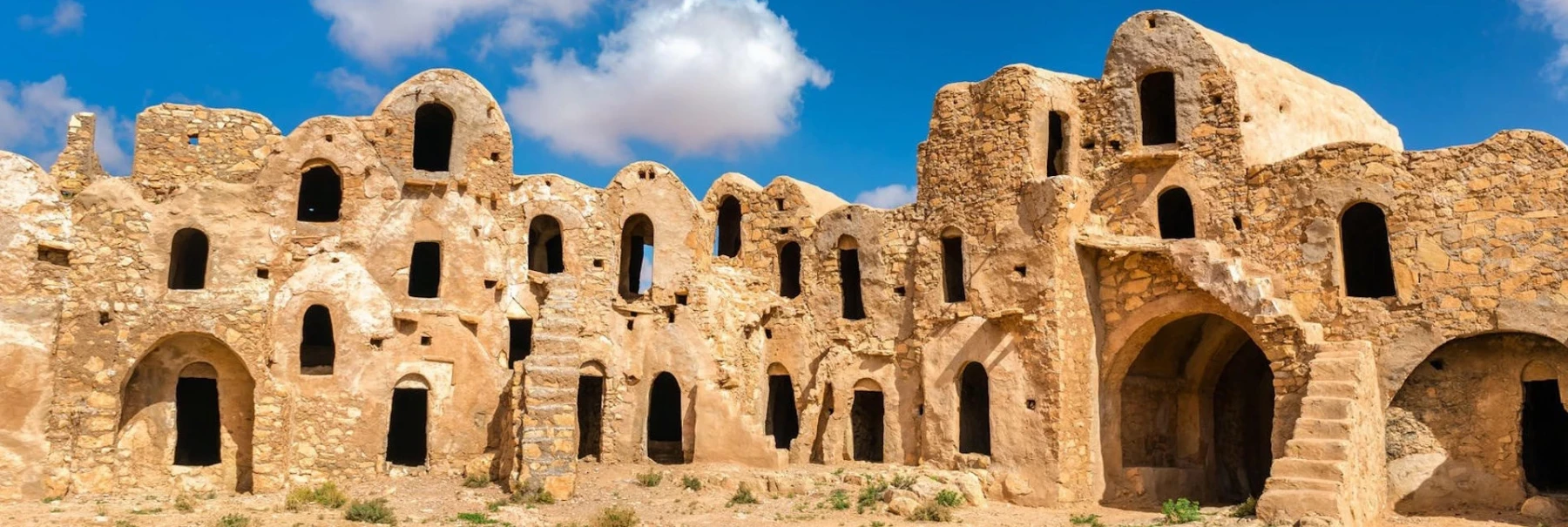Les 9 choses incontournables à faire à Le sud de la Tunisie
Dernière mise à jour : 26/05/2024 15:38Sommaire
Un voyage dans le sud de la Tunisie offre une aventure captivante au cœur du désert et des oasis, où la richesse culturelle se mêle aux paysages spectaculaires. À Tozeur, première étape de ce périple, la médina pittoresque et le musée de Dar Cherait plongent les visiteurs dans l'histoire locale. Une balade en calèche à travers les palmeraies de Tozeur offre une immersion tranquille dans ces oasis luxuriantes. Le voyage se poursuit avec une excursion dans le désert du Sahara, où une nuit en bivouac sous les étoiles permet une connexion authentique avec la nature.
À Douz, la "porte du désert", le marché vivant et le Festival du Sahara offrent une plongée dans la culture nomade. Le périple se poursuit à Tataouine, où les ksour de Chenini et Ksar Ouled Soltane révèlent une architecture berbère fascinante. Les routes mènent ensuite à Gabès, où la médina, le marché central et la poterie de Guellala enrichissent l'expérience culturelle. La plage de Gabès offre un moment de détente avant de conclure ce voyage riche en découvertes. Entre désert envoûtant, villages traditionnels et rencontres humaines, le sud tunisien révèle une facette unique et mémorable de ce pays.
1 - Djerba
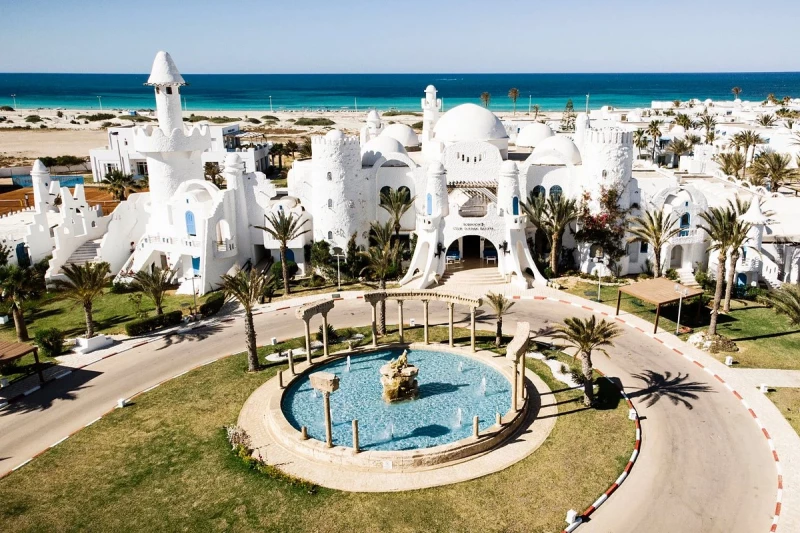
Djerba, une île enchanteresse nichée au sud-est de la Tunisie, séduit les visiteurs par sa riche diversité culturelle, son histoire captivante et ses paysages côtiers. Commencez votre exploration au cœur de Houmt Souk, la principale ville de l'île. Parcourez les marchés animés de sa médina, où les couleurs vibrantes des métiers locaux et la synagogue historique El Ghriba créent une ambiance captivante. Plongez dans le patrimoine culturel de Djerba en visitant le musée de Guellala, une vitrine de l'artisanat traditionnel, en particulier de la poterie. Au fil de la journée, détendez-vous sur les plages dorées de Sidi Mahrez, baignant dans la chaleur du soleil méditerranéen.
Pour une journée de loisirs et d'histoire, déambulez dans le village pittoresque de Guellala, renommé pour ses artisans potiers talentueux. Le lendemain matin, profitez du soleil sur les plages accueillantes de Djerba, telles que celles de Djerba Explore Park ou La Playa. L'après-midi, aventurez-vous à Guellala, célèbre pour ses ateliers de poterie authentiques, où vous pourrez acquérir des céramiques locales en guise de souvenirs. À la tombée de la nuit, parcourez les ruelles étroites de la médina d'Houmt Souk, admirant l'architecture traditionnelle et vous imprégnant de l'atmosphère animée.
Pour insuffler à votre périple une combinaison de nature et de culture, dirigez-vous vers la partie orientale de l'île pour explorer l'oasis de Ksar Ghilane. Traversez les dunes de sable, plongez dans les sources chaudes et savourez l'ambiance sereine du désert. Rendez-vous à Midoun, un village à l'architecture traditionnelle et aux marchés locaux, comprenant la remarquable mosquée Fadhloun et ses jardins environnants. Concluez votre séjour à Djerba en vous délectant d'une soirée de danse traditionnelle ou en savourant des délices locaux dans un restaurant authentique, enveloppant votre visite d'un mélange parfait de détente, d'histoire et de traditions tunisiennes.
En Savoir Plus  Nos astuces pour tirer le meilleur parti de votre expérience.
Nos astuces pour tirer le meilleur parti de votre expérience.
Lors de votre visite à Djerba, voici quelques astuces pour maximiser votre expérience et profiter au mieux de cette île enchanteuse :
-
Explorez la Médina de Houmt Souk tôt le matin : Pour éviter les foules, visitez la médina tôt le matin. C'est le moment idéal pour flâner dans les ruelles étroites, découvrir les marchés locaux et prendre des photos sans trop d'agitation.
-
Profitez des plages moins fréquentées : Djerba offre une variété de plages. Si vous préférez un environnement plus calme, explorez des plages moins connues comme celle de Djerba Explore Park ou de La Playa.
-
Dégustez la cuisine locale : Ne manquez pas de goûter aux délices culinaires tunisiens. Explorez les petits restaurants locaux à Houmt Souk pour déguster des plats traditionnels, en particulier les spécialités de fruits de mer.
-
Visitez El Ghriba avec respect : Si vous visitez la synagogue El Ghriba, soyez respectueux des pratiques religieuses et des traditions. Habillez-vous modestement et évitez les photographies à l'intérieur.
-
Participez à des activités locales : Recherchez des expériences locales telles que des ateliers de poterie à Guellala. Cela vous permettra de vous immerger davantage dans la culture artisanale de l'île.
-
Louez un véhicule pour plus de flexibilité : Pour explorer Djerba et ses environs à votre propre rythme, envisagez de louer une voiture. Cela vous permettra d'accéder facilement à des endroits plus éloignés.
-
Vérifiez les horaires des sites touristiques : Assurez-vous de connaître les horaires d'ouverture des sites touristiques que vous prévoyez de visiter, en particulier les musées et les monuments, pour éviter toute déception.
-
Profitez des coucher de soleil : Les couchers de soleil à Djerba peuvent être spectaculaires. Trouvez un bon emplacement sur la plage, les dunes ou à Houmt Souk pour apprécier ce moment magique.
-
Évitez les mois les plus chauds : Si possible, planifiez votre visite pendant la période de l'automne ou du printemps pour éviter les températures extrêmement élevées de l'été.
-
Soyez ouvert aux rencontres locales : Les habitants de Djerba sont chaleureux et accueillants. Soyez ouvert aux rencontres avec les habitants pour enrichir votre expérience culturelle.
En suivant ces astuces, vous pourrez profiter pleinement de votre séjour à Djerba en découvrant ses trésors culturels et naturels de manière authentique.
2 - Excursion dans le désert du Sahara
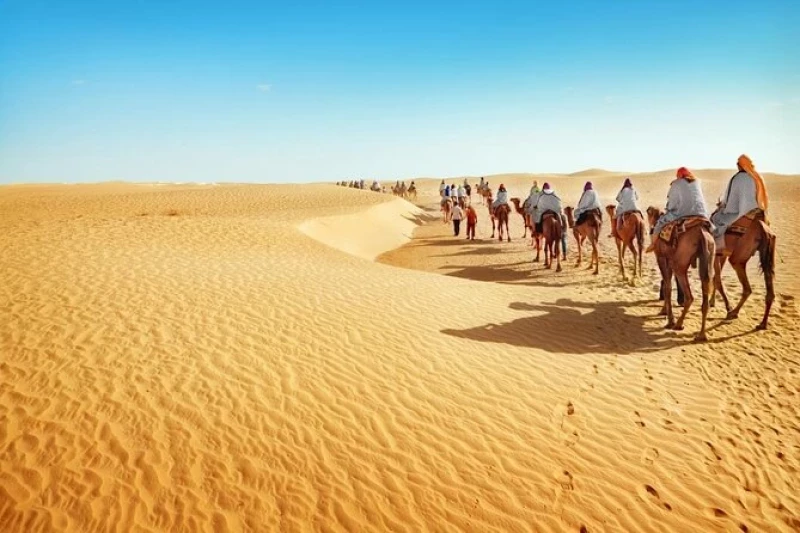
Une excursion dans le désert du Sahara tunisien promet une aventure extraordinaire au cœur de vastes étendues désertiques. En partant de points de départ tels que Ksar Ghilane, Douz, ou Tozeur, les voyageurs peuvent s'immerger dans des paysages époustouflants. Les balades à dos de chameau à travers les dunes de sable offrent une expérience authentique, permettant d'apprécier la majesté silencieuse du désert. Les nuits passées en bivouac sous un ciel étoilé ajoutent une dimension magique à cette aventure, offrant une proximité unique avec la nature.
L'exploration des oasis, comme Chebika, Tamerza, et Mides, révèle des joyaux verdoyants au milieu de l'aridité. Les randonnées à travers les dunes offrent des panoramas spectaculaires, tandis que les rencontres avec les communautés nomades locales permettent une immersion enrichissante dans la vie saharienne. Prévoir des vêtements adaptés, rester hydraté et engager un guide local compétent sont des aspects essentiels pour une expérience réussie.
Les voyageurs devraient aussi être sensibles à l'écologie du désert et respecter son équilibre fragile. En planifiant leur excursion en fonction des conditions météorologiques, ils peuvent maximiser leur sécurité et le plaisir de cette aventure inoubliable au cœur du Sahara tunisien.
 Nos astuces pour tirer le meilleur parti de votre expérience.
Nos astuces pour tirer le meilleur parti de votre expérience.
Partir en excursion dans le désert du Sahara nécessite une préparation minutieuse pour s'assurer d'une expérience enrichissante et sécurisée. Voici quelques astuces pour optimiser votre aventure dans le Sahara :
1. Hydratation Prioritaire : Apportez une quantité suffisante d'eau, car le désert peut être extrêmement sec. Assurez-vous d'avoir une gourde ou une bouteille d'eau facilement accessible.
2. Vêtements Adaptés : Habillez-vous légèrement pour la chaleur, mais prévoyez également des vêtements longs pour vous protéger du soleil intense et des températures plus fraîches la nuit. Un chapeau et des lunettes de soleil sont également essentiels.
3. Protection Solaire : Appliquez généreusement une crème solaire à indice élevé pour protéger votre peau contre les rayons UV puissants du soleil.
4. Informations Météorologiques : Vérifiez les conditions météorologiques avant votre départ. Les tempêtes de sable peuvent survenir, et il est important d'être informé des conditions actuelles.
5. Guides Locaux Expérimentés : Engagez des guides locaux expérimentés et bien informés sur la région. Ils peuvent non seulement garantir votre sécurité, mais également partager des connaissances sur la culture locale et la faune du désert.
6. Écologie du Désert : Soyez respectueux de l'environnement du désert. Évitez de perturber la faune et la flore locales, et assurez-vous de respecter les règles de conservation.
7. Bivouac Responsable : Si vous campez dans le désert, assurez-vous de minimiser votre impact environnemental. Ne laissez aucune trace et respectez les règles de camping responsable.
8. Sécurité Routière : Si vous conduisez, respectez les règles de sécurité routière. Les routes du désert peuvent être différentes des routes urbaines, alors conduisez prudemment.
9. Santé : Emportez une trousse de premiers soins basique. Il est également recommandé de vérifier si des vaccins spécifiques sont nécessaires avant de partir.
10. Communication : Assurez-vous d'avoir des moyens de communication fiables, que ce soit un téléphone satellite, une radio ou tout autre dispositif en cas d'urgence.
En suivant ces astuces, vous pouvez vous préparer adéquatement pour une expérience mémorable dans le désert du Sahara, en tirant le meilleur parti de cette aventure unique.
3 - Tozeur
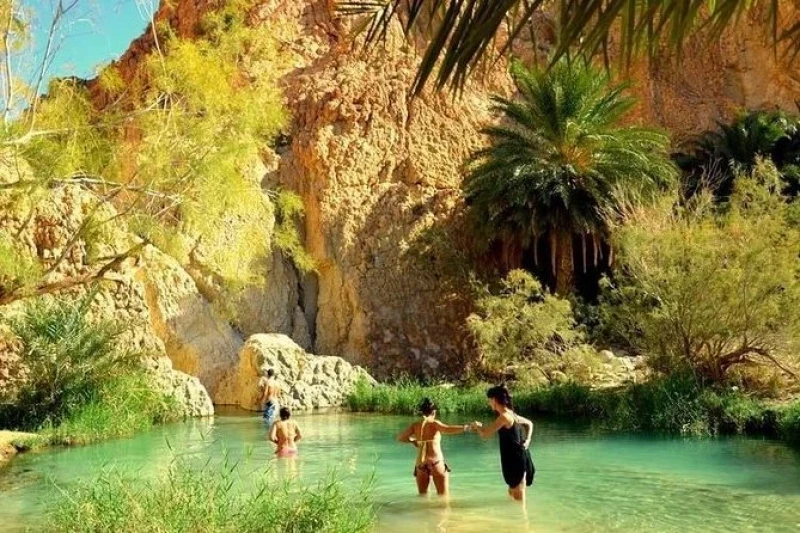
Tozeur, située au cœur de l'oasis tunisienne, offre une multitude de sites intéressants à visiter. Voici quelques endroits incontournables à explorer lors de votre visite à Tozeur :
-
Médina de Tozeur : Perdez-vous dans les ruelles étroites de la médina, où l'architecture traditionnelle tunisienne se mêle à l'effervescence des marchés locaux. Explorez les souks et découvrez l'artisanat local.
-
Oasis de Tozeur : Explorez les palmeraies de Tozeur, qui sont parmi les plus grandes du pays. Profitez d'une balade à dos de chameau ou à pied à travers les oasis verdoyantes, où les canaux d'irrigation serpentent entre les palmiers dattiers.
-
Musée Dar Cheraït : Ce musée offre un aperçu fascinant de l'histoire, de la culture et de l'artisanat de la région. Vous y trouverez des expositions sur les traditions sahariennes, les costumes locaux et l'artisanat traditionnel.
-
Médina de Nefta : Nefta, une ville voisine, possède également une médina charmante à explorer. Admirez l'architecture traditionnelle et imprégnez-vous de l'atmosphère paisible de cette ville.
-
Palmeraie de Nefta : À proximité de Tozeur, la palmeraie de Nefta offre des paysages similaires à ceux de Tozeur, avec ses vastes étendues de palmiers dattiers. C'est un endroit idéal pour une balade tranquille.
-
Chott el-Jérid : À quelques kilomètres de Tozeur, le Chott el-Jérid est un immense lac salé entouré de paysages désertiques. Les reflets changeants du ciel sur la surface du lac créent des scènes époustouflantes, surtout au lever ou au coucher du soleil.
-
Chebika : Ce village, surnommé le "paradis perdu", est niché au milieu des montagnes. Explorez ses gorges, ses cascades et ses vues panoramiques exceptionnelles.
-
Chak Wak Parc : Situé à Tozeur, ce parc offre une pause verdoyante avec des jardins bien entretenus, des fontaines et une atmosphère relaxante.
-
Dar Hi : Cet hôtel contemporain est également un exemple d'architecture innovante. Même si vous ne séjournez pas, vous pouvez visiter son café pour admirer son design unique.
-
Écomusée de Chak Wakti : Découvrez la culture et les traditions sahariennes à travers cet écomusée qui met en valeur le mode de vie local, l'agriculture et l'artisanat.
En explorant ces sites, vous découvrirez la diversité culturelle, historique et naturelle de Tozeur, offrant une expérience complète au cœur de l'oasis saharienne.
 Nos astuces pour tirer le meilleur parti de votre expérience.
Nos astuces pour tirer le meilleur parti de votre expérience.
Pour maximiser votre expérience lors de la visite de Tozeur, une oasis tunisienne unique, voici quelques astuces pratiques :
1. Choisir la Saison Idéale : Privilégiez la période d'automne au printemps pour des températures plus clémentes. Les mois d'octobre à avril sont souvent plus agréables pour explorer la région.
2. Hydratation et Protection Solaire : Étant donné le climat désertique, assurez-vous de rester hydraté en emportant de l'eau avec vous. Utilisez également une protection solaire adéquate, y compris des chapeaux et des lunettes de soleil.
3. Exploration des Oasis : Pour une expérience authentique, explorez les palmeraies à pied ou à dos de chameau. Les guides locaux peuvent fournir des informations sur la flore locale et l'histoire de l'oasis.
4. Visite de la Médina : Perdez-vous dans les ruelles de la médina de Tozeur. Les heures du matin sont souvent plus calmes, offrant une atmosphère plus authentique.
5. Musées et Écomusées : Visitez le Musée Dar Cheraït pour une plongée dans la culture locale. Ne manquez pas l'Écomusée de Chak Wakti pour une expérience immersive dans le mode de vie saharien.
6. Excursions dans le Désert : Organisez une excursion dans le désert environnant, en explorant des sites tels que Chott el-Jérid, Chebika, et les dunes de sable. Engagez des guides locaux pour une expérience enrichissante.
7. Shopping Responsable : Lors de vos achats dans les souks, soyez conscient de l'origine des produits. Encouragez l'achat de produits artisanaux locaux pour soutenir l'économie locale.
8. Photographie : Capturez les magnifiques paysages et l'architecture unique. Soyez respectueux en demandant la permission avant de prendre des photos, surtout dans des contextes plus traditionnels.
9. Éviter les Heures Chaudes : Planifiez vos activités en évitant les heures les plus chaudes de la journée. Préférez explorer le matin ou en fin d'après-midi.
10. S'Imprégner de la Culture : Participez à des événements culturels locaux ou assistez à des spectacles traditionnels pour une immersion plus profonde dans la vie locale.
En suivant ces astuces, vous pourrez profiter pleinement de votre visite à Tozeur, découvrant les trésors de cette oasis saharienne avec respect et authenticité.
4 - Le Chott El-Djérid
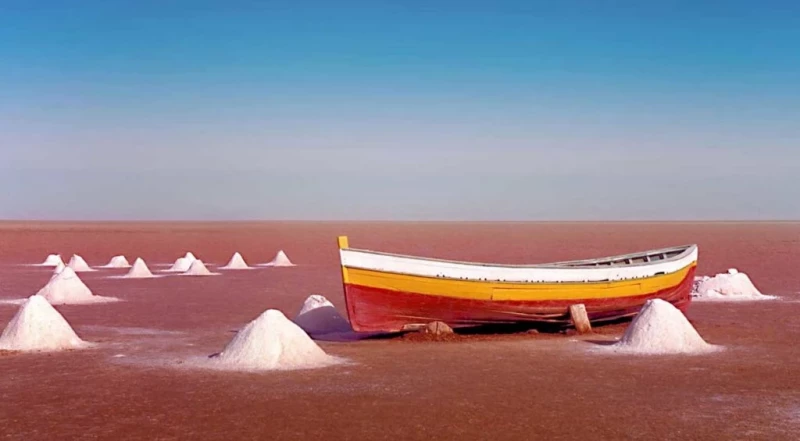
Le Chott el-Jérid, situé dans le sud-ouest de la Tunisie près de la ville de Tozeur, est un remarquable lac salé endoréique qui s'étend sur environ 5 000 kilomètres carrés. C'est le plus grand lac salé de la Tunisie, présentant un paysage extraordinaire de sel blanc étincelant, résultant de l'évaporation rapide de l'eau dans cette région aride. Sa nature saline en fait un site unique, largement exploité pour l'extraction du sel.
Entouré d'une végétation adaptée aux conditions salines, le Chott el-Jérid abrite un écosystème unique, où des espèces résilientes ont évolué pour prospérer dans cet environnement extrême. Les rives du lac offrent des panoramas spectaculaires, avec des reflets changeants du ciel créant des paysages visuellement époustouflants, particulièrement impressionnants au lever ou au coucher du soleil.
Tozeur, ville voisine, sert de point de départ idéal pour explorer le Chott el-Jérid. Les visiteurs peuvent organiser des excursions pour admirer cette merveille naturelle, découvrant les villages environnants, observant la faune locale et apprenant les techniques traditionnelles d'extraction du sel. C'est un lieu emblématique qui témoigne de la beauté saisissante du désert tunisien.
 Nos astuces pour tirer le meilleur parti de votre expérience.
Nos astuces pour tirer le meilleur parti de votre expérience.
Pour optimiser votre visite du Chott el-Jérid, le plus grand lac salé de Tunisie situé près de Tozeur, voici quelques astuces pratiques :
- Prévoyez une Visite au Lever ou au Coucher du Soleil : Les reflets changeants du ciel sur la surface du lac offrent des vues spectaculaires. Planifiez votre visite tôt le matin ou en fin d'après-midi pour une expérience visuelle encore plus impressionnante.
- Organisez une Excursion Guidée : Engagez un guide local ou participez à une excursion organisée pour en apprendre davantage sur l'histoire, la géologie et la faune de la région. Les guides locaux peuvent partager des informations enrichissantes sur la vie dans le désert.
- Respectez l'Écosystème Fragile : Le Chott el-Jérid abrite une faune et une flore adaptées aux conditions salines. Soyez respectueux de l'environnement en évitant de perturber la vie sauvage et en ne laissant aucune trace de votre passage.
- Préparez-vous aux Conditions Climatiques : Étant donné que la région peut être très chaude, assurez-vous d'avoir de l'eau en quantité suffisante, des vêtements légers, un chapeau et une protection solaire pour vous protéger du soleil intense.
- Appréciez le Silence et la Sérénité : Le Chott el-Jérid offre une atmosphère paisible. Prenez le temps d'apprécier le calme du désert, le reflet du ciel sur le lac et l'immensité de cet espace.
- Explorez les Environs : Profitez de votre visite pour explorer les villages environnants, découvrir la vie locale et peut-être même déguster des produits artisanaux proposés par les habitants.
- Photographiez les Paysages Uniques : Capturez les contrastes visuels uniques entre le sel, le ciel et les environs désertiques. Le Chott el-Jérid offre d'excellentes opportunités de photographie.
- Vérifiez les Conditions Routières : Si vous conduisez, assurez-vous de vérifier les conditions routières, en particulier si vous prévoyez de vous aventurer sur les routes moins fréquentées. Les pistes peuvent être irrégulières.
- Appréciez la Culture Locale : Profitez de votre séjour à Tozeur pour découvrir la culture locale, notamment en goûtant à la cuisine traditionnelle et en participant à des activités culturelles.
En suivant ces astuces, vous pourrez tirer le meilleur parti de votre visite au Chott el-Jérid, en vous immergant pleinement dans la beauté et la tranquillité de ce paysage désertique unique.
5 - Chenini et Ksar Ouled Soltane
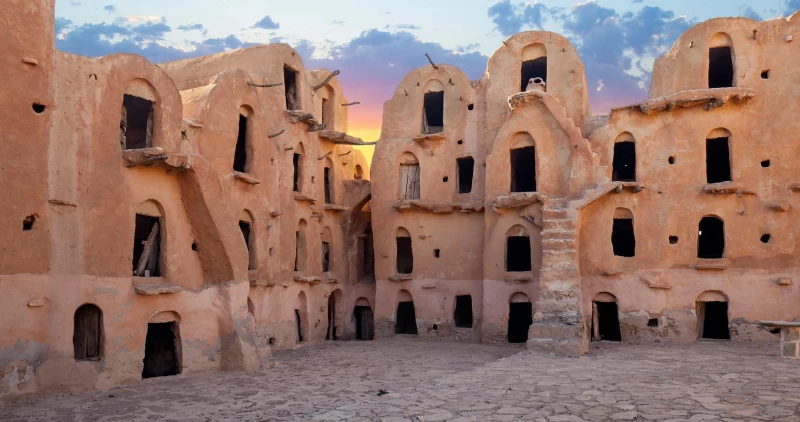
Chenini et Ksar Ouled Soltane sont deux sites historiques et culturels exceptionnels situés dans la région du sud de la Tunisie. Voici une présentation de chacun de ces lieux :
Chenini :
Chenini est un village berbère perché sur une colline dans la région montagneuse du Dahar, près de la ville de Tataouine. Voici quelques points saillants de Chenini :
-
Architecture Troglodytique : Chenini est renommé pour son architecture troglodytique, avec des maisons construites dans les falaises. Ces habitations semi-troglodytiques sont caractéristiques de la région et offrent un aperçu unique de la vie traditionnelle berbère.
-
Mosquée et Fort : Le village abrite une vieille mosquée qui témoigne de l'histoire islamique de la région. Il y a également un ancien fort qui offre une vue panoramique sur les environs.
-
Artisanat Local : Explorez les ruelles de Chenini pour découvrir l'artisanat local, y compris les tapis berbères colorés et d'autres produits artisanaux traditionnels.
Ksar Ouled Soltane :
Ksar Ouled Soltane est un ksar (fortification) situé près de la ville de Tataouine. Il est réputé pour son architecture en gradins et son rôle dans la saga Star Wars. Voici quelques éléments caractéristiques de Ksar Ouled Soltane :
-
Architecture en Gradins : Ksar Ouled Soltane est connu pour ses greniers collectifs en gradins, appelés "ghorfas". Ces structures en forme de boîtes empilées étaient utilisées pour le stockage des céréales et ont été construites de manière à maximiser l'espace tout en permettant une ventilation adéquate.
-
Apparition dans Star Wars : Le site a été utilisé comme lieu de tournage pour plusieurs scènes de la saga Star Wars, ajoutant à son attrait pour les fans de cinéma.
-
Patrimoine Culturel : Ksar Ouled Soltane est un exemple impressionnant du patrimoine architectural et culturel de la région. Les visiteurs peuvent explorer les ghorfas et en apprendre davantage sur la vie des communautés agricoles d'autrefois.
Ces deux sites offrent une plongée captivante dans l'histoire, la culture et l'architecture de la Tunisie méridionale, et ils sont des destinations incontournables pour ceux qui souhaitent découvrir le riche patrimoine de la région.
 Nos astuces pour tirer le meilleur parti de votre expérience.
Nos astuces pour tirer le meilleur parti de votre expérience.
Pour tirer le meilleur parti de votre visite à Chenini et Ksar Ouled Soltane, deux sites exceptionnels en Tunisie, voici quelques astuces pratiques :
Chenini :
-
Guide Local : Engagez un guide local pour bénéficier d'informations approfondies sur l'histoire de Chenini, son architecture troglodytique et la vie locale. Cela ajoutera une dimension enrichissante à votre visite.
-
Heures Matinales : Visitez Chenini tôt le matin pour éviter la chaleur de la journée et profiter de la tranquillité du village. Les lumières matinales peuvent également créer des ambiances photographiques uniques.
-
Rencontre avec les Habitants : Soyez ouvert à la rencontre avec les habitants. Les locaux peuvent partager des récits fascinants sur la vie dans le village et offrir des conseils sur les endroits à explorer.
-
Randonnée dans les Environs : Explorez les sentiers pédestres autour de Chenini pour découvrir des vues panoramiques et des paysages naturels à couper le souffle. Certains sentiers mènent à des points de vue spectaculaires.
Ksar Ouled Soltane :
-
Horaire de Visite : Comme pour Chenini, préférez visiter Ksar Ouled Soltane tôt le matin pour éviter les températures élevées. Cela vous donnera également la possibilité de capturer de superbes photos.
-
Compréhension de l'Architecture : Engagez-vous avec les panneaux d'information sur place ou demandez à un guide pour mieux comprendre l'architecture en gradins de Ksar Ouled Soltane. Cela ajoutera une appréciation plus profonde de la complexité du site.
-
Exploration Intérieure : Explorez l'intérieur des ghorfas pour voir comment les communautés utilisaient ces structures pour stocker leurs récoltes. C'est une immersion unique dans l'histoire agricole de la région.
-
Photographie : Si vous êtes amateur de photographie, Ksar Ouled Soltane offre d'innombrables opportunités avec ses structures en gradins et son ambiance unique. Soyez créatif avec votre composition.
Conseils Généraux :
-
Respect de la Culture : Respectez les coutumes locales et demandez la permission avant de photographier des personnes ou des propriétés privées.
-
Hydratation : Assurez-vous d'avoir de l'eau avec vous, surtout lors des visites matinales. Les températures peuvent monter rapidement, même tôt dans la journée.
-
Confort Vestimentaire : Portez des vêtements légers et confortables, ainsi qu'un chapeau pour vous protéger du soleil.
En suivant ces astuces, votre visite à Chenini et Ksar Ouled Soltane sera non seulement agréable mais aussi enrichissante sur le plan culturel et historique.
6 - Les oasis de Chebika, Tamerza et Mides
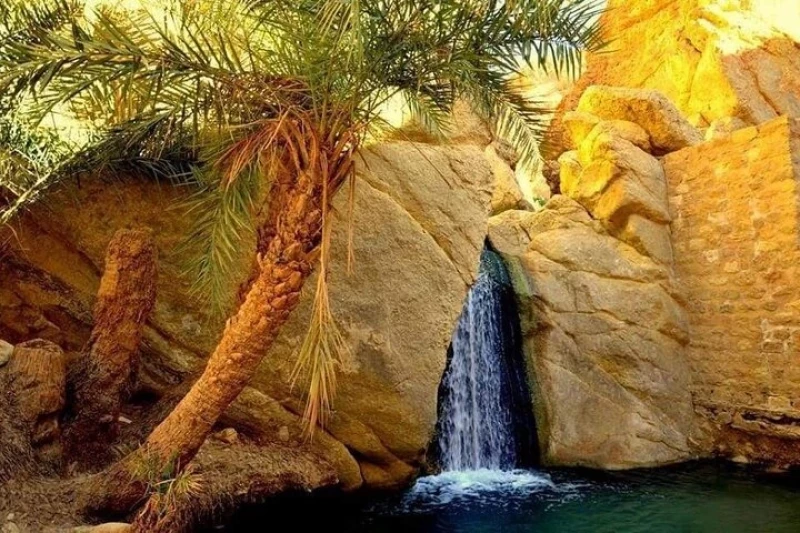
Les oasis de Chebika, Tamerza et Mides forment un ensemble impressionnant dans le sud-ouest de la Tunisie. Chacune de ces oasis offre une expérience unique, combinant des paysages naturels spectaculaires avec une riche histoire culturelle. Voici un aperçu de ces trois oasis :
Chebika :
-
Oasis Verdoyante : Chebika est souvent appelée "l'oasis des montagnes". Elle est nichée au pied des montagnes de l'Atlas et offre un contraste frappant entre le vert des palmiers et la roche désertique environnante.
-
Ruines Romaines : Explorez les ruines romaines de Chebika, notamment des vestiges de bains romains qui témoignent de l'ancienne occupation de la région.
-
Panorama depuis le Belvédère : Montez jusqu'au belvédère pour profiter d'une vue panoramique sur l'oasis et les montagnes environnantes. C'est un endroit idéal pour prendre des photos mémorables.
Tamerza :
-
Plus Grande Oasis de Montagne : Tamerza est la plus grande oasis de montagne en Tunisie. Son paysage est caractérisé par des palmeraies luxuriantes et des cascades naturelles.
-
Ancien Village et Cascade : Explorez l'ancien village de Tamerza, partiellement détruit par une inondation en 1969. Ne manquez pas la cascade de Tamerza, une chute d'eau impressionnante au cœur de l'oasis.
-
Randonnée dans les Gorges de Mides : Tamerza offre un point de départ pour des randonnées dans les Gorges de Mides voisines, où les paysages montagneux et les formations rocheuses sont à couper le souffle.
Mides :
-
Gorges de Mides : Mides est connue pour ses gorges impressionnantes. Ces canyons profonds et étroits offrent des vues spectaculaires, particulièrement au lever et au coucher du soleil.
-
Ancien Village Rupestre : Explorez l'ancien village rupestre de Mides, construit dans les falaises, avec ses habitations troglodytiques. C'était un lieu de vie traditionnel pour les habitants.
-
Observation de l'Oued : L'oued (lit de rivière) de Mides offre des panoramas uniques. Prenez le temps de vous asseoir et d'apprécier la sérénité de cet environnement naturel.
En visitant ces oasis, vous découvrirez une facette captivante de la Tunisie, mêlant nature, histoire et culture d'une manière exceptionnelle.
 Nos astuces pour tirer le meilleur parti de votre expérience.
Nos astuces pour tirer le meilleur parti de votre expérience.
Pour tirer le meilleur parti de votre visite aux oasis de Chebika, Tamerza et Mides en Tunisie, voici quelques astuces pratiques :
Chebika :
-
Visite tôt le matin : Planifiez votre visite à Chebika tôt le matin pour profiter de températures plus fraîches et de la douce lumière matinale, rehaussant la beauté de l'oasis.
-
Exploration du Belvédère : Prenez le temps de monter jusqu'au belvédère pour profiter d'une vue panoramique époustouflante sur Chebika et ses environs. C'est un endroit idéal pour la photographie.
-
Visite guidée : Envisagez de recruter un guide local pour vous donner des informations sur l'histoire, la flore et la faune de Chebika. Les guides peuvent enrichir votre expérience avec leurs connaissances.
Tamerza :
-
Chaussures Confortables : Portez des chaussures de marche confortables, surtout si vous prévoyez d'explorer les sentiers de Tamerza ou de visiter l'ancien village. Certaines zones peuvent avoir un terrain irrégulier.
-
Excursion à la Cascade : Ne manquez pas la cascade de Tamerza. Envisagez de prendre une excursion guidée pour vous assurer d'explorer la région en toute sécurité et d'apprendre sur sa signification géologique et culturelle.
-
Perspectives Historiques : Engagez la conversation avec les habitants ou les guides pour en apprendre davantage sur l'histoire du vieux village et sur la manière dont la communauté s'est adaptée aux défis naturels de l'oasis.
Mides :
-
Exploration des Gorges : Explorez les gorges de Mides, et si vous aimez la randonnée, envisagez de faire une randonnée guidée pour apprécier pleinement les formations géologiques impressionnantes et les paysages pittoresques.
-
Immersion Culturelle : Visitez l'ancien village rupestre de Mides pour vous immerger dans la culture locale. Respectez la signification historique du site et écoutez les éventuelles histoires partagées par les habitants.
-
Observation du Lever/Coucher du Soleil : Si possible, planifiez votre visite à Mides pour coïncider avec le lever ou le coucher du soleil. Les couleurs changeantes et les ombres sur les parois du canyon créent un spectacle captivant.
Conseils Généraux :
-
Dégustation de la Cuisine Locale : Essayez les plats et boissons locaux dans les villes voisines. La cuisine tunisienne est riche et diversifiée, offrant des saveurs uniques.
-
Protection Solaire : Apportez de la crème solaire, un chapeau et des lunettes de soleil pour vous protéger du soleil intense, surtout en plein midi.
-
Respect des Coutumes Locales : Soyez attentif aux coutumes locales et demandez la permission avant de prendre des photos de personnes ou de propriétés privées.
En incorporant ces conseils dans votre visite, vous vivrez une expérience plus agréable et enrichissante en explorant les captivantes oasis de Chebika, Tamerza et Mides.
7 - Ksar Ghilane
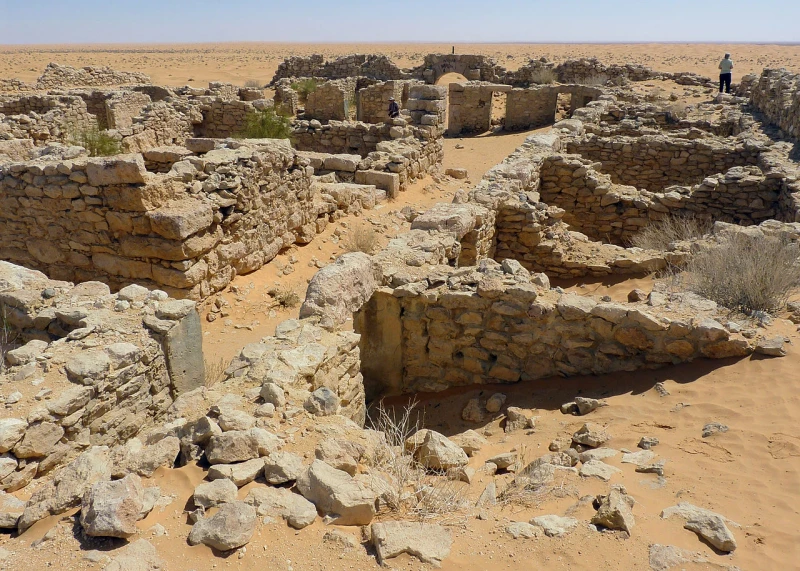
Ksar Ghilane est une oasis située au cœur du désert tunisien, dans la région du Sahara. Voici une présentation de cet endroit unique :
Ksar Ghilane :
-
Oasis au Milieu du Désert : Ksar Ghilane est une oasis isolée, entourée de dunes de sable à perte de vue. C'est l'une des rares oasis accessibles par la route dans le désert tunisien.
-
Source Thermale : L'attraction principale de Ksar Ghilane est sa source d'eau thermale, réputée pour ses propriétés thérapeutiques. Les visiteurs peuvent se baigner dans des bassins d'eau chaude, créant un contraste saisissant avec le désert environnant.
-
Campements dans le Désert : La région offre la possibilité de séjourner dans des campements traditionnels au cœur des dunes. C'est une expérience authentique pour ceux qui souhaitent vivre la vie nomade et profiter du ciel étoilé du désert.
-
Visite du Ksar : Le ksar lui-même, un ancien fort, ajoute une dimension historique à l'endroit. Les visiteurs peuvent explorer ses ruines et imaginer son rôle dans le passé en tant que point de relais pour les caravanes.
-
Activités Aventures : Les amateurs d'aventure peuvent profiter des excursions en 4x4, des promenades à dos de chameau dans les dunes, ou même des expéditions en quad pour explorer les vastes étendues du désert.
-
Observation du Coucher du Soleil : L'oasis offre des vues spectaculaires sur le coucher du soleil. Les couleurs changeantes du sable et du ciel créent un spectacle visuel impressionnant.
-
Réserve Naturelle : La région autour de Ksar Ghilane est également une réserve naturelle, abritant une variété de faune et de flore adaptées aux conditions désertiques.
Ksar Ghilane offre une expérience unique, combinant la sérénité d'une oasis avec l'aventure du désert, faisant de cet endroit un incontournable pour ceux qui recherchent une évasion authentique dans le sud tunisien.
 Nos astuces pour tirer le meilleur parti de votre expérience.
Nos astuces pour tirer le meilleur parti de votre expérience.
Pour tirer le meilleur parti de votre visite à Ksar Ghilane, une oasis unique dans le désert tunisien, voici quelques astuces pratiques :
Préparation et Équipement :
-
Vêtements Légers et Protecteurs : Portez des vêtements légers et longs pour vous protéger du soleil intense et du sable. Un chapeau à large bord et des lunettes de soleil sont également recommandés.
-
Chaussures Appropriées : Optez pour des chaussures confortables, surtout si vous prévoyez de marcher dans les dunes. Des sandales fermées peuvent être pratiques pour les activités dans l'oasis.
-
Protection Solaire : Appliquez généreusement de la crème solaire, en particulier sur les zones exposées, pour éviter les coups de soleil.
Séjour à Ksar Ghilane :
-
Choix d'Hébergement : Explorez différentes options d'hébergement, y compris les campements traditionnels dans les dunes pour une expérience immersive du désert.
-
Expérience Thermale : Profitez pleinement de la source thermale. Prévoyez de vous y rendre tôt le matin ou en fin d'après-midi pour éviter la chaleur de la journée.
-
Nuit dans le Désert : Si possible, optez pour une nuit sous les étoiles dans le désert. Les nuits sont souvent paisibles et offrent une vue imprenable sur le ciel étoilé.
Activités et Exploration :
-
Excursions Guidées : Considérez la possibilité de participer à des excursions guidées en 4x4, à dos de chameau, ou en quad pour explorer les environs et les dunes.
-
Observation du Coucher de Soleil : Assistez au coucher de soleil depuis les dunes pour une expérience visuelle exceptionnelle. Préparez-vous avec un appareil photo pour capturer des moments mémorables.
-
Respect de la Nature : Soyez respectueux de l'écosystème fragile du désert. Évitez de perturber la faune et la flore locales, et suivez les conseils des guides pour minimiser votre impact.
Sécurité et Logistique :
-
Hydratation Continue : Portez une attention particulière à votre hydratation, en particulier en raison des températures élevées du désert. Assurez-vous d'avoir suffisamment d'eau avec vous.
-
Planification des Activités : Planifiez vos activités tôt le matin ou en fin d'après-midi pour éviter les heures les plus chaudes de la journée.
En suivant ces astuces, votre expérience à Ksar Ghilane sera non seulement agréable mais aussi enrichissante, offrant une immersion totale dans la beauté et la culture du désert tunisien.
8 - Matmata
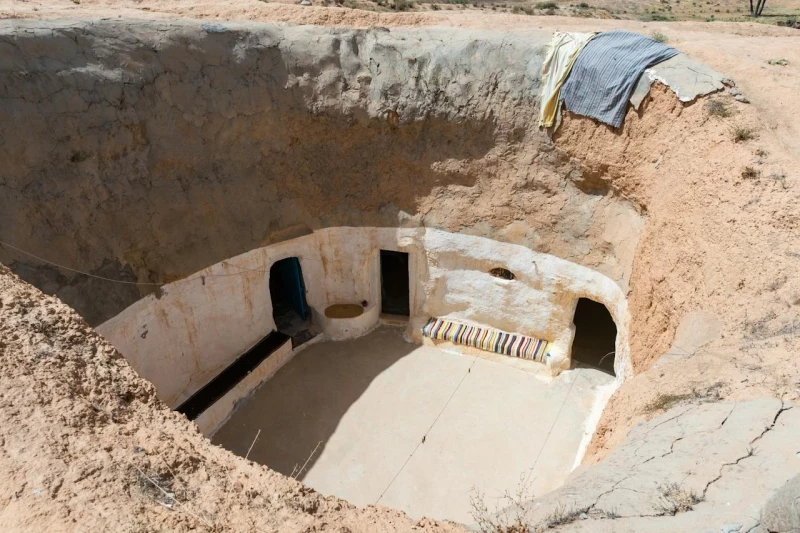
Matmata est une région exceptionnelle située dans le sud de la Tunisie, réputée pour son paysage lunaire et ses habitations troglodytiques. Voici un aperçu de ce lieu fascinant :
Matmata :
-
Habitations Troglodytiques : L'attraction principale de Matmata réside dans ses maisons troglodytiques. Ces habitations creusées dans le sol et les parois rocheuses offrent une fraîcheur bienvenue dans le climat aride du désert.
-
Voyage dans le Temps : En visitant les maisons troglodytiques, vous aurez l'impression de remonter dans le temps. Certaines d'entre elles ont été habitées depuis des générations et sont une représentation vivante du mode de vie traditionnel.
-
Scène de Tournage de Star Wars : Matmata a gagné une renommée mondiale en tant que lieu de tournage pour Star Wars. La maison troglodytique de Berber Lars, située à Matmata, a été utilisée comme décor pour la maison des Lars sur la planète Tatooine.
-
Marché Local : Explorez le marché local de Matmata pour découvrir l'artisanat local, y compris les tapis, les poteries et d'autres produits artisanaux uniques.
-
Vue Panoramique depuis les Collines : Montez jusqu'aux collines environnantes pour une vue panoramique sur le paysage désertique et les maisons troglodytiques dispersées.
-
Rencontre avec les Habitants : Soyez ouvert à la rencontre avec les habitants. Les Berbères de Matmata sont connus pour leur hospitalité chaleureuse et peuvent partager des récits intéressants sur leur vie dans le désert.
Matmata offre une expérience unique et mémorable, entre histoire, culture et une connexion profonde avec la nature désertique du sud tunisien.
 Nos astuces pour tirer le meilleur parti de votre expérience.
Nos astuces pour tirer le meilleur parti de votre expérience.
Pour optimiser votre visite à Matmata, une région emblématique de la Tunisie, voici quelques astuces pratiques :
Préparation et Équipement :
-
Protection Solaire : En raison du climat aride, assurez-vous d'apporter une protection solaire adéquate, y compris de la crème solaire, un chapeau et des lunettes de soleil.
-
Vêtements Adaptés : Optez pour des vêtements légers et confortables, mais qui couvrent bien pour vous protéger du soleil. Des chaussures de marche confortables sont également recommandées.
Découverte des Habitats Troglodytiques :
-
Visite Guidée : Engagez un guide local pour une visite guidée des maisons troglodytiques. Cela vous permettra de mieux comprendre l'histoire et la culture de la région.
-
Respect de la Vie Privée : Soyez conscient de la vie privée des habitants. Demandez la permission avant de prendre des photos, en particulier à l'intérieur des habitations.
Interaction Culturelle :
-
Rencontre avec les Locaux : Profitez de l'occasion pour interagir avec les habitants de Matmata. La population locale est connue pour sa convivialité, et une conversation peut enrichir votre expérience.
-
Découverte du Marché Local : Explorez le marché local pour découvrir l'artisanat traditionnel. C'est l'endroit idéal pour acheter des souvenirs uniques.
Exploration des Environs :
-
Ascension des Collines : Grimpez jusqu'aux collines environnantes pour une vue panoramique sur Matmata et ses environs. Cela offre également de belles opportunités de photographie.
-
Excursions dans les Environs : Profitez des possibilités d'excursions dans les environs pour découvrir d'autres sites troglodytiques et les paysages désertiques qui caractérisent la région.
Conseils Généraux :
-
Hydratation Régulière : En raison du climat désertique, assurez-vous de rester hydraté. Portez toujours une bouteille d'eau avec vous.
-
Respect de l'Environnement : Soyez respectueux de l'environnement. Évitez de laisser des déchets et suivez les conseils locaux pour minimiser votre impact.
En suivant ces astuces, votre expérience à Matmata sera non seulement agréable mais aussi riche en découvertes culturelles et naturelles.
9 - Participer aux festivals locaux
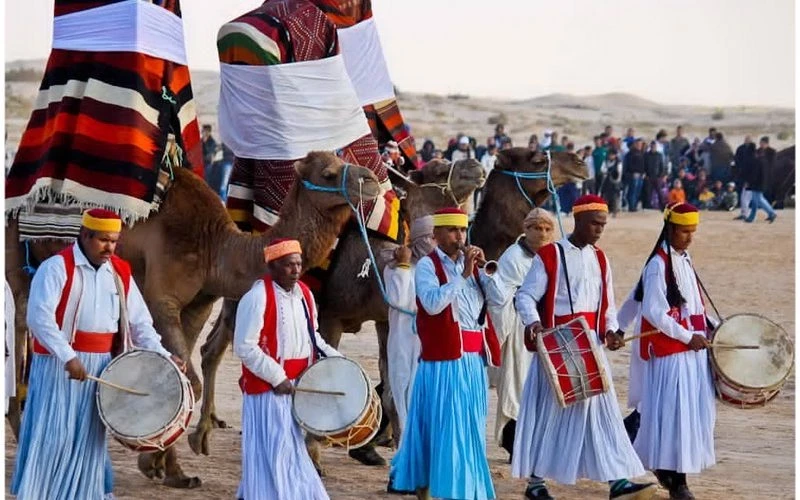
La région du sud de la Tunisie, caractérisée par son riche patrimoine culturel, abrite plusieurs festivals célébrant la musique, la danse, l'artisanat, et d'autres aspects de la vie locale. Bien que la disponibilité des festivals puisse varier d'une année à l'autre, voici quelques-uns des festivals qui ont été organisés dans la région :
-
Festival International de Douz: Aussi connu sous le nom de "Festival du Sahara", il se tient à Douz, souvent surnommée la "porte du désert". Il met en avant la culture nomade, la musique saharienne, et propose des activités telles que des courses de chameaux et des démonstrations équestres.
-
Festival de Tozeur: Tozeur, célèbre pour ses palmeraies, accueille divers événements culturels, artistiques et musicaux. Le festival met en valeur la musique traditionnelle tunisienne et offre une plateforme aux artistes locaux.
-
Festival de Tataouine: Ce festival met l'accent sur la culture locale, en mettant en avant la musique, la danse, et les traditions artisanales de la région de Tataouine. Il offre aux visiteurs une expérience authentique du patrimoine tunisien.
-
Festival de Gabès: Gabès organise divers festivals, notamment des événements culturels qui célèbrent la musique, la danse, et la cuisine locale. Certains festivals mettent également en avant des thèmes environnementaux et agricoles.
-
Festival de Djerba: Djerba accueille plusieurs festivals, dont certains sont dédiés à la musique traditionnelle, à l'art contemporain, ou aux sports nautiques. Ces festivals reflètent la diversité culturelle et artistique de l'île.
-
Festival de Kebili: Kebili organise des événements culturels, artistiques et sportifs. Ces festivals mettent souvent en lumière les traditions locales, y compris la musique du désert et les danses traditionnelles.
-
Festival des Oasis de Tozeur: Axé sur la promotion du tourisme durable, ce festival célèbre les oasis en mettant en avant la richesse de la culture oasienne. Il inclut des concerts, des expositions d'artisanat, et des activités éducatives.
Assurez-vous de vérifier les dates spécifiques et la disponibilité des festivals au moment de votre visite, car ils peuvent varier d'une année à l'autre. Participer à ces festivals offre une occasion unique de découvrir la riche culture et l'hospitalité du sud de la Tunisie.
 Nos astuces pour tirer le meilleur parti de votre expérience.
Nos astuces pour tirer le meilleur parti de votre expérience.
Participer aux festivals locaux dans le sud de la Tunisie peut être une expérience immersive et enrichissante. Voici quelques astuces pour tirer le meilleur parti de votre participation :
Recherche Préalable :
-
Calendrier des Festivals : Avant votre voyage, consultez le calendrier des festivals locaux pour vous assurer de ne pas manquer les événements prévus pendant votre séjour.
-
Thèmes et Activités : Renseignez-vous sur les thèmes et les activités spécifiques de chaque festival. Certains mettent en avant la musique traditionnelle, la danse, l'artisanat, tandis que d'autres peuvent avoir un focus sur l'agriculture ou l'environnement.
Préparation Personnelle :
-
Tenue Appropriée : Habillez-vous de manière respectueuse en tenant compte de la culture locale. Si le festival a une tenue traditionnelle, n'hésitez pas à l'adopter.
-
Accessoires Utiles : Apportez des accessoires tels que des chapeaux, des lunettes de soleil et des éventails pour vous protéger du soleil, surtout si le festival se déroule en plein air.
Participation Active :
-
Engagez-vous dans les Activités : Soyez actif pendant le festival. Participez aux danses, essayez la cuisine locale, et engagez-vous avec les artistes et les artisans.
-
Ateliers et Démonstrations : Profitez des ateliers et des démonstrations organisés pendant le festival. C'est une excellente opportunité pour apprendre des compétences artisanales locales ou des danses traditionnelles.
Rencontres Locales :
-
Échange Culturel : Engagez-vous dans des conversations avec les habitants. Les festivals sont souvent des moments privilégiés pour découvrir la vie locale et échanger sur les traditions.
-
Achats Responsables : Si des produits artisanaux sont proposés, privilégiez l'achat direct auprès des artisans locaux pour soutenir l'économie locale.
Respect des Traditions :
-
Respect des Règles du Festival : Respectez les règles et les coutumes du festival. Certains festivals peuvent avoir des rituels spécifiques, soyez attentif et suivez les indications des organisateurs.
-
Photographie Respectueuse : Si vous prenez des photos, demandez la permission aux personnes que vous photographiez. Soyez respectueux de la vie privée des participants.
Logistique :
-
Planification des Déplacements : Assurez-vous d'avoir un moyen de transport fiable pour vous rendre au festival, surtout si celui-ci se tient dans une région éloignée.
-
Santé et Hydratation : Restez hydraté, surtout par temps chaud. Apportez de l'eau et protégez-vous du soleil pour assurer votre bien-être pendant le festival.
En suivant ces astuces, vous pourrez profiter pleinement de l'atmosphère festive tout en respectant la culture et les traditions locales du sud de la Tunisie.
Le sud de la Tunisie - Où Loger ?
Pour visiter le sud de la Tunisie, il est recommandé de choisir des logements qui offrent un mélange de confort, d'authenticité et de proximité avec les principales attractions de la région. Voici quelques suggestions de lieux où loger dans différentes villes du sud tunisien :
-
Tozeur : Optez pour un hôtel ou un riad au cœur de la médina de Tozeur pour une immersion dans l'ambiance locale. Les établissements près des palmeraies offrent souvent une vue magnifique. Certains hôtels proposent également des expériences traditionnelles comme des soirées sous les étoiles dans le désert.
-
Douz : En tant que point de départ pour les excursions dans le désert, choisissez un hôtel confortable à Douz. Les établissements près du marché offrent généralement un accès facile aux activités locales, tandis que les lodges dans le désert offrent une expérience unique.
-
Tataouine : Séjournez dans un hôtel ou une maison d'hôtes dans la vieille ville de Tataouine pour une expérience authentique. Certains logements proposent des visites guidées des ksour et des régions avoisinantes.
-
Gabès : Choisissez un hôtel près de la médina de Gabès pour explorer les marchés et la vie locale. Les hôtels le long de la côte offrent souvent des vues magnifiques sur la mer.
-
Ksar Ghilane : Si vous envisagez de visiter l'oasis de Ksar Ghilane, recherchez des campements ou des lodges dans cette région pour une expérience unique dans le désert, avec la possibilité de vous baigner dans les sources d'eau chaude.
-
Chenini ou Matmata : Pour une immersion totale dans les ksour et les maisons troglodytes, envisagez de séjourner dans un hôtel ou une maison d'hôtes situé dans ces villages berbères.
Assurez-vous de réserver vos logements à l'avance, en tenant compte de vos préférences personnelles, du type d'expérience que vous recherchez et de la proximité des attractions que vous souhaitez visiter.
Le sud de la Tunisie - Comment se déplacer ?
Pour vous déplacer et explorer le sud de la Tunisie, vous avez plusieurs options de transport en fonction de votre itinéraire et de vos préférences. Voici quelques moyens de transport couramment utilisés pour visiter cette région :
-
Location de voiture : La location de voiture offre une flexibilité maximale pour explorer la région à votre rythme. Les routes principales sont en bon état, mais assurez-vous de vérifier les conditions routières et d'obtenir des informations sur les itinéraires avant votre voyage.
-
Transports en commun : Les bus interurbains sont disponibles pour relier les principales villes du sud, mais leur fréquence peut être limitée, surtout pour les endroits plus éloignés. Les gares routières principales se trouvent dans les centres-villes.
-
Taxis : Les taxis locaux peuvent être une option pratique pour se déplacer à l'intérieur des villes ou entre les villes. Assurez-vous de négocier le prix avant le départ ou demandez l'utilisation du compteur.
-
Excursions organisées : Si vous préférez ne pas conduire vous-même, de nombreuses agences de voyages proposent des excursions organisées qui couvrent plusieurs attractions du sud tunisien. Ces excursions peuvent inclure des guides, des transports et parfois même des logements.
-
Vols intérieurs : Si votre itinéraire inclut des destinations éloignées, vous pouvez envisager des vols intérieurs vers les aéroports régionaux. Assurez-vous de vérifier les disponibilités de vols et de choisir les options qui correspondent le mieux à votre planification.
-
Transferts privés : Certains hôtels et agences de voyages proposent des transferts privés entre les destinations. Cela peut être une option confortable, mais vérifiez les coûts associés.
-
Location de véhicules tout-terrain : Pour les expéditions dans le désert, vous pouvez opter pour la location de véhicules tout-terrain avec chauffeur. Cela peut être nécessaire pour accéder à des endroits plus reculés ou pour des expériences spécifiques comme le safari dans le désert.
Lors de la planification de votre voyage, prenez en compte la distance entre les attractions, les conditions routières, et la disponibilité des moyens de transport. Il peut être utile de combiner plusieurs options en fonction de votre itinéraire.
Le sud de la Tunisie - Meilleure période
La meilleure période pour visiter le sud de la Tunisie, notamment la région désertique, est pendant les mois d'automne et de printemps. Les mois de septembre à novembre et de mars à mai offrent généralement des conditions météorologiques agréables, avec des températures modérées, évitant ainsi les chaleurs extrêmes de l'été.
-
Automne (septembre à novembre) : Les températures commencent à baisser après l'été, ce qui rend cette période idéale pour explorer le désert du Sahara. Les journées sont encore chaudes, mais les nuits peuvent être fraîches.
-
Printemps (mars à mai) : Cette période est également favorable avec des températures agréables. Les paysages sont souvent plus verts après les pluies hivernales, et les conditions sont propices aux excursions dans le désert et aux visites des oasis.
Pendant l'été (juin à août), les températures dans le sud tunisien peuvent devenir extrêmement élevées, dépassant souvent les 40 degrés Celsius. Les conditions peuvent être difficiles pour les activités en plein air, en particulier dans le désert, où la chaleur peut être intense. Il est donc recommandé d'éviter cette période si possible.
Il est important de noter que les conditions météorologiques peuvent varier d'une année à l'autre, et il est toujours conseillé de vérifier les prévisions météorologiques avant de planifier votre voyage. Assurez-vous également de prendre en compte les événements spécifiques que vous souhaitez expérimenter, tels que les festivals locaux ou les floraisons saisonnières.
